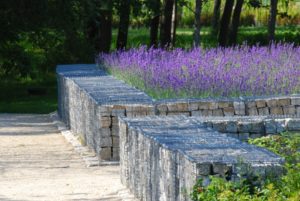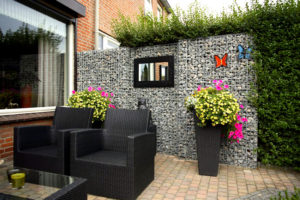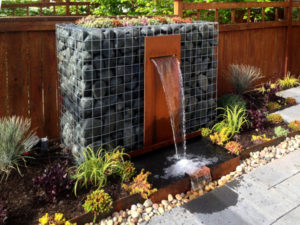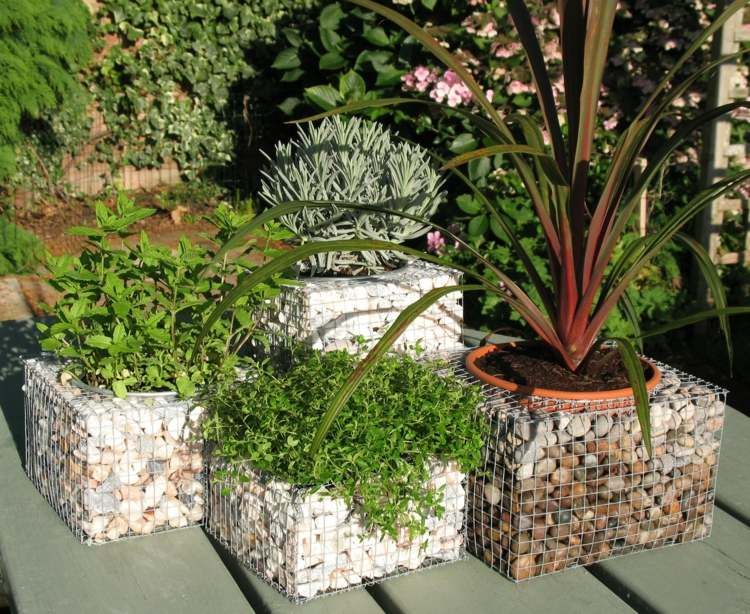What happens to gabions today, otherwise than “boom” cannot be called. Textured and elegant containers made of nets filled with stones can be seen in the city and beyond, in the garden plots.
Landscape designers, as if competing, find the gabions all new and new applications.
Everyone knows that many things have come, have been created by wars. Jerricans, for example, microwave ovens, duct tape or canned food, invented by Napoleon’s technologists. The history of gabions is also connected with the French emperor. He widely used high, without a bottom, baskets to protect trenches and guns. Mobile structures, from the Italian word for “a big cage”, were called tours or gabions, from the Italian word meaning ” a big cage.” In military affairs, gabions are still used. But, since the end of the last century, more and more in engineering. Light, mobile, but durable, gabions, as practice showed, perfectly strengthen the slopes, beaches, risky, in terms of possible landslides, sites. In recent years, gabion structures have become very popular with “green” architects and landscape designers. Basic types of gabion products The main varieties, in fact, are three: gabions are box-shaped, cylindrical and the mattress (Reno mattresses).

The first, in the form of a parallelepiped, strengthen steep banks, slopes, walls, make of the high fences. The latter is presented in the form of cylindrical baskets, more suitable for creating decorative accessories – columns and the like. Third, lining gently sloping places, fix the bottoms of water bodies. These are the basic types of gabions, but their variations are, of course, more: cubic, spherical, cone-shaped…
Gabions can be of almost any shape, with any filling, which makes these constructions particularly attractive in the eyes of landscape design specialists. Advantages and disadvantages of gabions. Mesh cells have many advantages, among them: Strength. Typically, the gabion skeleton consists of a very strong, double-twisted wire and reinforcement.
Durability. Gabion products do not crack, do not tear, do not break from loads. They do not deform when the soil is drafted. Flexibility. Thanks to the wire structure, “large cells” tolerate soil erosion without problems, even if it occurs at the base of the structure. Resistance to moisture. Gabions absorb water without being destroyed. This quality is especially valuable if the site is located in the so-called erosion zone. Indispensable gabions and in the case where additional drainage is required.
Breath-ability. Creating the impression of a deaf, monolithic fence, gabions, nevertheless, well pass air. Ecological compatibility. In fashion, everything that has a prefix “eco”, and gabions – a sample of naturalness.
Aesthetics. Gabions have a catchy, textured, always neat appearance. Price availability. Gabions are much cheaper than concrete analogs and are unpretentious in operation. Do they have flaws? A disadvantage is that many people consider the complexity of installing large and tall gabion sections. In this case, experts are attracted to the installation. Where are the gabions used? The field of application of mesh containers is quite extensive. Let’s list the most popular variants of using gabions in landscape design: – Teargassing. Unsuccessful relief will save gabions. With their help, you can straighten and align the platform, located at an angle, create a multi-stage terrace. – Retaining walls. Boxes filled with stones, wooden blocks or spills, marvelously harmonize with lush greenery and flowers. And if you add a canopy or arch to this symbiosis, a secluded, shady arbor will come out. – Fences and fences. Gabions, combining a different filler, you can surround the entire estate. Or cover up the farm buildings, obscure the compost pit.
Of the gabions build like the entire fence and let’s say its sole part. Then wooden shields or boxes with vegetation are fastened to this basis. You can alternate a hedge and gabions: a beautiful bush, next to a mesh section and again a bush. Where large fences are undesirable, low barriers and even borders are made of gabions. The field for creativity, “games”, configurations are so wide that a separate term has appeared – persons. So, the same bulk walls and partitions are called, whose function is too zonate and decorate the site. Mattress gabions strengthen the bottom and box-like – the shore. Specialists advise the finish of the reservoir with gabions if the soil on the site is too wet and requires improvement of the drainage system. In this case, note that the shape of the reservoir can be any, and gabions can become not only a successful engineering solution but also a beautiful tank finish. Form them from the sides, and an ordinary pond will reincarnate into a noble pool. – Street fireplaces, fires, barbecues, too, can be laid out of strong boxes filled with fire-resistant stones. – Garden furniture, benches and tables can be really implemented from small formes. Similar objects are made by combining various fillers or the gabions themselves with other materials – ceramic plates, tempered glass, wood. For example, a compact pile of light stones, fastened with a net and covered with glass, easily turns into a tea table. And the wooden countertop on the gabion becomes larger as a dining table. Of gabions, you can even add a garden version of the bar.
 Alpinarium – and it can be done by resorting to a mesh construction. Such an alpine slide will not “creep” while retaining as strict but spectacular appearance. Gabions also emphasize flowerbeds, frame ladders, and paths, separate trees, form columns, arches, pedestals for garden lanterns, urns and vases for flowers, abstract figures, and even sculptures… Gabions are an unusually diverse and plastic building and decoration material.
Alpinarium – and it can be done by resorting to a mesh construction. Such an alpine slide will not “creep” while retaining as strict but spectacular appearance. Gabions also emphasize flowerbeds, frame ladders, and paths, separate trees, form columns, arches, pedestals for garden lanterns, urns and vases for flowers, abstract figures, and even sculptures… Gabions are an unusually diverse and plastic building and decoration material.
After all, the “filling” of honeycomb boxes can be very different! What is filled with gabion mesh? The first, “soldiers” tanks were stuffed with earth, grass, and driftwood, everything that fell under the arm. The most popular, however, are gabions with stone “insides.” Such, by the way, from ancient times do not only in Europe but also in Japan. There are fragments of granite, sandstone, dolomite, marble, gypsum spar, quartzite, limestone, gneiss, basalt, gravel, river pebbles… An ordinary cage full of stones will suit any architecture, any style of landscape art. But it is not a sin to retreat from the classics. Say, add to artificial minerals artificial, glowing in the dark – imagine how enchanting it looks, with luminescence, the structure? Quite often, also combine different rock types to create, for example, a color gradation: a dark base and a light, “airy” top. Or lay out the pattern – stones of one shade against the background of stones of another, contrasting. Beautifully obtained when, say, black labradorite alternate with light, silvery quartzite, saturated red or green granite, forming bands or waves. And, sometimes, in the gabions interspersed lumpy glass and fixed inside the LED-backlight. Look like luminous boxes, like a frozen, petrified flame. Do you prefer naturalness, ease? – Then we recommend not to fill the containers to the very top, but leave them half-empty: over time, in the gaps between the stones, the grass will germinate, and the half-glass gabions will turn out. In addition to stones, mesh containers are filled with spills, logs, fragments of bricks or tiles, bark or glass bottles… Everything that fits into the style and design.
What do you need to know about the installation of gabions?
The double torsion grid, of which such billets consist, is most often galvanized, moreover, it is covered with an anti-corrosive composition, due to which it tolerates negative natural influences. The market also offers extra-strong containers, from bridges and rods connected by welding. The bigger the load is supposed to be, the rougher these rods are, and the bridges more often. As for the filler, there is a proven formula: for “land” designs, the size of the stones should be about one-third greater than the diameter of the cell. For underwater gabions, only stones larger than cells are suitable by 50%. If you put gabions to strengthen the soil or the support considers the properties of the filler stone, its strength, resistance to frost, moisture resistance. Clearly, there are fewer requirements for decorative gabions.


Leave a Reply